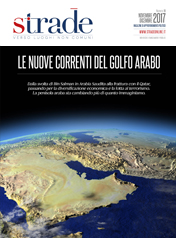Gulf Economic Visions: how to redesign the Arab Gulf economy
Novembre/Dicembre 2017 / Monografica
Oil dependence and public sector hypertrophy make the Gulf economies structurally different from those of other developed countries but at the same time impose complete reform as a matter of national security for countries of the region.

The year 2018 will be an important one for the Gulf economic visions: the planning stages are in the rearview mirror, and the focus is squarely on implementation. What makes these visions special, and what are some of the key challenges on the horizon?
The growth chapter of a standard economics textbook contains numerous principles on what makes economies grow. These apply to virtually all “standard” economies, but the Gulf economies are “non-standard,” meaning that many of the traditional maxims do not apply. Viewed through this lens, the Gulf economic visions can be thought of as efforts to transform the economies into a standard form. Though the differences are many, two are particularly relevant to the growth of the economy.
First, in the Gulf countries, oil dominates the economy; it directly accounts for a large share of economic activity, and much of the rest of the economy is downstream of the sectors that are directly dependent upon oil. This is significant because real oil prices neither grow according to a long-term trend, nor do they exhibit mean-reversion (a tendency for periods of above normal growth to be followed by the reverse, or vice versa). They approximately follow what statisticians refer to as a “random walk,” meaning that the best prediction of future prices is basically today’s prices. This implies that the economy does not have a latent propensity to grow. Growing oil production will help the economy grow, but that is physically capped in the long-run as wells are eventually depleted.
In contrast, in a standard, diversified economy, most sectors grow consistently because they are positively affected by technological progress. For example, when advances in artificial intelligence improve worker productivity or diminish transportation costs, many sectors experience an increase in performance, which will translate to higher levels of economic growth. The oil sector certainly benefits from technological progress, but only very narrowly, and not on a consistent basis.
The implication of this difference can be seen in the wake of the 2014 oil price crisis. When standard economies went through the global financial crisis of 2008, their economies contracted for a year or more, but they eventually recovered their previous growth levels, as the main source of growth—technological progress—was fundamentally unaffected by the crisis. But when oil prices fell in 2014-2016, there was no latent tendency for them to recover to their previous levels, meaning that oil-dependent economies are facing the prospect of a permanent decline in living standards.
Governments in the Gulf and other resource-rich states do, however, take countermeasures, the most important of which is investing oil profits in large sovereign wealth funds. These investments expose the Gulf economies to “standard” sources of growth since they often include purchases of shares in companies operating in regular economies. However, even the largest sovereign wealth funds in the world, such as those of Abu Dhabi and Saudi Arabia, do not possess the capital necessary to maintain growth at the scale of the entire economy, especially given the living standards that citizens currently enjoy.
The second key difference is the prevalence of public sector hiring. In the 1970s, as the Gulf countries both secured their independence and witnessed soaring oil prices, the governments started to hire a larger percentage of citizens in the public sector. Among the multiple reasons for this strategy was the desire to provide citizens with a comfortable lifestyle, especially compared to the notoriously tough lives that the Gulf peoples have lived throughout history due to the arid climate. Public sector jobs often had very low workloads (including short hours), and wages that considerably exceeded what could be justified by the worker’s productivity, and what could be earned competing for a job in the private sector, which is what most of the globe’s citizens have to do.
While enjoyable at the level of the individual worker, the Gulf labor market setup severely stunted the economy’s level of growth for several reasons. First, government administrative work is not a source of economic growth; it is a stagnant sector which rarely witnesses improvements in productivity. Second, offering such high wages in the public sector impairs the private sector’s ability to attract citizens, and to engage them in the jobs that actually contribute to economic growth, such as those in the high technology sectors. Third, a minority of the surfeit of workers in the government sectors sit idle and seek to create red tape procedures that damage the economy, as a way of justifying promotions for themselves. Running a business in a resource-rich state is often highly bureaucratic compared to a standard economy, because the army of public sector workers want to secure their role in the economy. Fourth, this structure creates distorted educational attainments, as citizens focus on getting credentials that help with public sector promotions rather than the productivity-enhancing qualifications that serve the needs of the private sector. That means too many master’s degrees in business administration, and not enough in engineering. These two differences between standard economies and the Gulf ones reinforce each other and render the Gulf economies fundamentally under-equipped to grow in a consistent fashion. As chance would have it, oil prices have been generally trending up since the 1970s (with many bumps), most notably during the new millennium, aiding the Gulf economies, but that trend seems to have come to an end during the last three years.
The Gulf economic visions are essentially about undoing these two distinctive structural characteristics: diversifying the economy away from oil to establish a consistent source of growth; and moving people out of the public sector and into the private sector so that they can contribute to growing sectors. Traditional economic reform packages, such as the UK in the 1980s, or France at the present time, involve moving away from dying industries and liberalizing components of the economy. The scale of changes is comparatively small, as they represent a minor reshuffle of the economy’s resources. The Gulf economic visions are a comprehensive reconfiguration of the economy.
Saudi Arabia started this process in earnest during 2017 and all the Gulf economies have taken substantive steps along these lines. They include privatizing state enterprises, freezing public sector hiring, investing in new sectors that are associated with job creation and technological progress, such as renewable energy and arms manufacturing, introducing detailed performance criteria for government organizations, removing barriers to entrepreneurship, and more.
Inevitably, the economic visions have encountered pockets of stiff resistance. Citizens enjoy cushy public sector jobs and contractors enjoy the extravagant purchases of governmental organizations unencumbered by strict budget constraints. Bureaucrats working in the oil sector enjoy wielding massive influence over the economy. Previously, such opposition may have been enough to seriously derail the reforms. However, 2017 is different, as improving the performance of the economy has become an issue of national security. The widespread recognition of this fact among local stakeholders has helped the Gulf governments overcome expected bumps in the road. For example, Saudi Arabia’s decision to allow women to drive was broadly welcomed across the population precisely because so many have correctly perceived the previous ban as an impediment to the economy. Expect an acceleration in 2018, as the peoples of the Gulf continue on their unique and unprecedented transformation projects.
INDICE Novembre/dicembre 2017
Editoriale
Monografica
- Golfo Arabo, l’anno che non c’era: cosa, come e perché della crisi del Qatar
- Arabia Saudita, primi importanti passi verso il cambiamento
- Generare forza attraverso l’unità: l’esempio del Bahrein
- Separare la politica dalla religione: un anno di riforme in Bahrein
- Emirati Arabi Uniti, un 2017 in crescita
- Kuwait e Oman, i mediatori del Golfo
- Gulf Economic Visions: come riprogettare l’economia del Golfo
- Arab Gulf, the year that wasn’t: the who, what and why of the Qatar crisis
- Saudi Arabia, the first important step towards change
- Generating strength through unity: the example of Bahrain
- Separating politics from religion: a year of reforms in Bahrain
- United Arab Emirates, a 2017 of growth
- Kuwait and Oman, mediators of the Gulf
- Gulf Economic Visions: how to redesign the Arab Gulf economy









